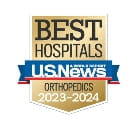Orthopedics & Sports Medicine
U.S. PATIENTS:713.790.3333
INTERNATIONAL PATIENTS:+1.713.441.2340

Houston Methodist Hospital is ranked Best in Texas and No. 16 in the nation by U.S. News & World Report for Orthopedics. U.S. News & World Report has also named Houston Methodist Hospital one of the nation's best as a nationally ranked Honor Roll hospital. Learn more.
Your body is made to move. The specialists at Houston Methodist Orthopedics & Sports Medicine use the latest technology, perform minimally invasive procedures and develop customized treatment plans, including physical therapy, just for you.
We are also proud to be the official health care provider for Houston's premier professional sports teams and fine arts organizations. We also serve hundreds of area high schools and youth teams.
We treat all patients with the same standard of care we provide top athletes and performing artists, including:
- Experience – Our fellowship-trained surgeons are highly experienced and specialized. They perform more than 20,000 orthopedic procedures each year.
- Innovation – With the latest minimally invasive, imaging, and pain management techniques, there is nothing we can’t handle.
- Research – Our physicians work with academic medicine researchers to develop new techniques, enhancing orthopedic care.
- Collaboration – Our team of experts works together to develop an individualized treatment plan for you.
Whether your goal is to get back in the game — or just walk down the stairs — we make your quality of life our highest priority. And, because no two orthopedic cases are the same, we tailor our solutions and treatment specifically for your unique needs.
Ready to learn more about how our experts can keep you moving? Call us at 713.790.3333 for help finding an orthopedic specialist.
Orthopedics & Sports Medicine Specialties
Advanced Orthopedic Care
As one of Houston’s most experienced comprehensive orthopedics group, we treat a wide range of common and complex conditions.
Sports Medicine & Performance
Professional athletes and performing artists count on us to keep them running, jumping, pitching and dancing. We treat all patients with the same high-quality, elite care.

